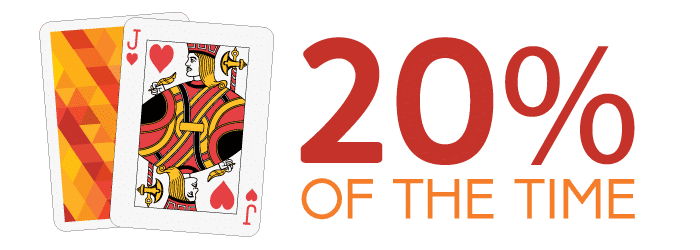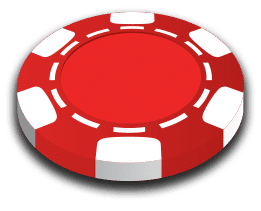It’s natural when you play hold’em to put possible hands into categories. You’ve got sets, two pair hands, top pairs, middle pairs, flush draws, gutshots, ace-high hands, and so on. Then when you think about how you will play a hand, you consider how you’d generally play other hands in the same category, and you play the hand that way. If you would typically call with middle pairs, and you have a middle pair hand, then you call. If you would typically raise your flush draws, and you have a flush draw, you raise.
While this is a perfectly natural way to think about no-limit hold’em strategy, it is one that is fraught with large amounts of peril. In fact, it’s basically impossible to play using these heuristics and not make massive errors in some situations.
The problems become greater the fewer natural categories there are. Consider this flop:
Q♦ 9♠ 7♦
What are natural hand categories on this flop? You can have sets, two pairs, overpairs, top pairs, unimproved pocket pairs (above nine, 8-8, and below seven), middle pairs, bottom pairs, flush draws (with two overcards, with one overcard, with no overcards, with an open-ended straight draw, with a pair, and with a gutshot), straight draws (open-ended and gutshots), ace-high hands (with and without backdoor draws), and total air (with and without backdoor draws).
That’s a lot of categories. It’s so many categories, that if you look at a hand range on the flop, each of these categories makes up only a small percentage of the total range. So if you decide you’re going to play all hands in a certain category the same way, your strategy still has a lot of flexibility because you have so many different ways to play the entire set of categories.
In general, average no-limit hold’em players react to flops like the one above with a fairly reasonable strategy. They raise some good hands, they bluff some of their draws, and they call a lot because many hands are still “in it” at this point.
Now consider the following board after the river card.
Q♦ 9♠ 7♦ T♣ 8♣
How many categories are there now? There are hands with jacks in them (K-J and all other jack hands), hands with sixes in them, sets, two pair hands, and everything else. Sure, you could have a pair of queens versus a pair of sevens, but in practice these one pair (and worse) hands will generally get lumped together once the board turns out like this.
On the flop there were more than a dozen easily identifiable hand categories. Now there are five or six. What’s the problem with this?
Say you decide you’re going to play every hand in each category the same way. If you have a jack, you’ll do one thing. If you have a six, you’ll do another. If you have a set, you’ll do another. And so on. Since each of these categories comprises a larger percentage of the total hand range, your strategy begins to become inflexible.
Say, for the sake of argument, you have a jack 20 percent of the time, a six 5 percent of the time, a set 10 percent of the time, two pair 10 percent of the time, and something else 55 percent of the time. (I don’t need ultra-realistic numbers to make the point.)

What if I bet pot at you? You could decide to call with the first four categories and fold the fifth. That has you calling 45% of the time and folding 55% of the time. Since I’m getting even money on my bet, if you fold 55% of the time, I can bet 100% of my hands and show a profit.
But I don’t have to bet pot. I can bet half-pot. Does that change your strategy? If you are adhering to categories, it probably doesn’t. You’re likely to call with the first four categories and fold the fifth. But now I make a whole lot more profit, since I am giving myself 2-to-1 odds on my bluff.
All I have to do is understand roughly how your hands are distributed within your range and assume that you’ll tend to play all hands in a category the same way, and I can exploit your strategy by adjusting my bet size to give you the most trouble.
I could go the other way, also. I could increase my bet size to try to get you to fold additional categories. What if I thought that if I bet twice the pot that you’d fold everything except the first category? Now you’re folding 80% of all hands, and even though I’m risking much more than the pot, I’m still making a profit betting every single hand in my range.
Now consider this board
J♦ 9♠ 7♦ T♣ 8♣
There are three categories: K-Q, any queen, and playing the board. Say hand distribution is 3 percent K-Q, 17 percent any queen, and 80 percent playing the board. If I bet and you’re playing the board, do you call?
With most players, there is a bet size where that answer changes from yes to no. And it changes instantly for every single hand in the category. You’re either calling with all your board playing hands, or you’re folding them all.
If your strategy is inflexible like this, then you are enormously exploitable. I won’t go through every possibility, but here’s one. Say your number is half-pot. If I bet less than half-pot, then you’ll call, and if I bet more than half-pot, you’ll fold.

I can bet somewhat more than half-pot with every hand and absolutely brutalize you. I’m giving myself nearly 2-to-1 odds on my bluff, and you’re folding 80 percent of the time. I’m robbing you blind.
The fix is to split your categories. Instead of either calling or folding everything in one category, you split it up. An easy way to do that is use the cards in your hand to build sub-categories. You can have hands where you’re playing the board and you hold two cards in your hand that appear on the board (i.e., “set” and “two pair” hands), hands where you hold two of the flush draw cards, hands where you hold one of the board cards, and so on.
There are smart ways to do this, but that discussion will have to wait for another article…


great article Ed. I recently heard about your book, Poker’s 1%, and I heard you talk about it a bit on a podcast. That particular podcast may have been quite dated, it was on my ipod and I looked for a date but did not see one. Anyway, it sounded interesting as did you talk about it, so I will be looking into it.
Glad you liked the article. The podcast couldn’t be too dated since the book itself is only a couple months old.
hi ED.your book pokers 1% is ecxellent.